Sheraz Ahmed
German Research Center for Artificial Intelligence, DFKI GmbH, Kaiserslautern, Rhineland-Palatinate, Germany, DeepReader GmbH, Kaiserlautern, Germany
LD-ViCE: Latent Diffusion Model for Video Counterfactual Explanations
Sep 10, 2025Abstract:Video-based AI systems are increasingly adopted in safety-critical domains such as autonomous driving and healthcare. However, interpreting their decisions remains challenging due to the inherent spatiotemporal complexity of video data and the opacity of deep learning models. Existing explanation techniques often suffer from limited temporal coherence, insufficient robustness, and a lack of actionable causal insights. Current counterfactual explanation methods typically do not incorporate guidance from the target model, reducing semantic fidelity and practical utility. We introduce Latent Diffusion for Video Counterfactual Explanations (LD-ViCE), a novel framework designed to explain the behavior of video-based AI models. Compared to previous approaches, LD-ViCE reduces the computational costs of generating explanations by operating in latent space using a state-of-the-art diffusion model, while producing realistic and interpretable counterfactuals through an additional refinement step. Our experiments demonstrate the effectiveness of LD-ViCE across three diverse video datasets, including EchoNet-Dynamic (cardiac ultrasound), FERV39k (facial expression), and Something-Something V2 (action recognition). LD-ViCE outperforms a recent state-of-the-art method, achieving an increase in R2 score of up to 68% while reducing inference time by half. Qualitative analysis confirms that LD-ViCE generates semantically meaningful and temporally coherent explanations, offering valuable insights into the target model behavior. LD-ViCE represents a valuable step toward the trustworthy deployment of AI in safety-critical domains.
DocVCE: Diffusion-based Visual Counterfactual Explanations for Document Image Classification
Aug 06, 2025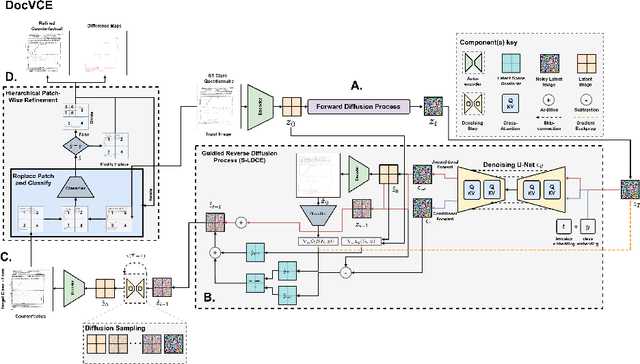
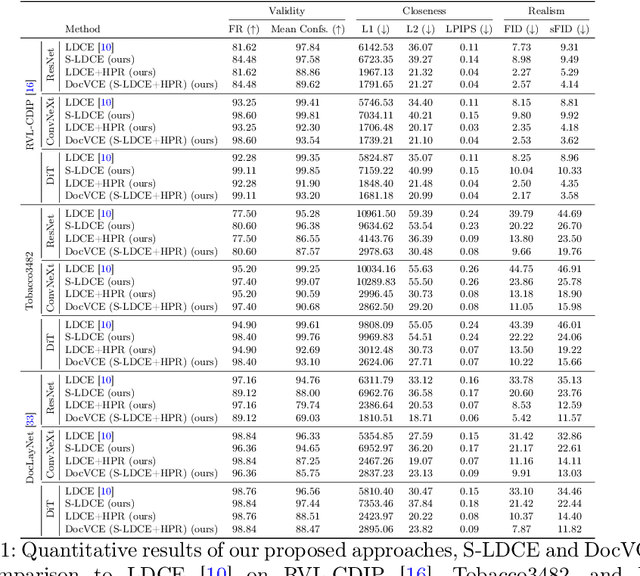


Abstract:As black-box AI-driven decision-making systems become increasingly widespread in modern document processing workflows, improving their transparency and reliability has become critical, especially in high-stakes applications where biases or spurious correlations in decision-making could lead to serious consequences. One vital component often found in such document processing workflows is document image classification, which, despite its widespread use, remains difficult to explain. While some recent works have attempted to explain the decisions of document image classification models through feature-importance maps, these maps are often difficult to interpret and fail to provide insights into the global features learned by the model. In this paper, we aim to bridge this research gap by introducing generative document counterfactuals that provide meaningful insights into the model's decision-making through actionable explanations. In particular, we propose DocVCE, a novel approach that leverages latent diffusion models in combination with classifier guidance to first generate plausible in-distribution visual counterfactual explanations, and then performs hierarchical patch-wise refinement to search for a refined counterfactual that is closest to the target factual image. We demonstrate the effectiveness of our approach through a rigorous qualitative and quantitative assessment on 3 different document classification datasets -- RVL-CDIP, Tobacco3482, and DocLayNet -- and 3 different models -- ResNet, ConvNeXt, and DiT -- using well-established evaluation criteria such as validity, closeness, and realism. To the best of the authors' knowledge, this is the first work to explore generative counterfactual explanations in document image analysis.
Discovering Concept Directions from Diffusion-based Counterfactuals via Latent Clustering
May 11, 2025Abstract:Concept-based explanations have emerged as an effective approach within Explainable Artificial Intelligence, enabling interpretable insights by aligning model decisions with human-understandable concepts. However, existing methods rely on computationally intensive procedures and struggle to efficiently capture complex, semantic concepts. Recently, the Concept Discovery through Latent Diffusion-based Counterfactual Trajectories (CDCT) framework, introduced by Varshney et al. (2025), attempts to identify concepts via dimension-wise traversal of the latent space of a Variational Autoencoder trained on counterfactual trajectories. Extending the CDCT framework, this work introduces Concept Directions via Latent Clustering (CDLC), which extracts global, class-specific concept directions by clustering latent difference vectors derived from factual and diffusion-generated counterfactual image pairs. CDLC substantially reduces computational complexity by eliminating the exhaustive latent dimension traversal required in CDCT and enables the extraction of multidimensional semantic concepts encoded across the latent dimensions. This approach is validated on a real-world skin lesion dataset, demonstrating that the extracted concept directions align with clinically recognized dermoscopic features and, in some cases, reveal dataset-specific biases or unknown biomarkers. These results highlight that CDLC is interpretable, scalable, and applicable across high-stakes domains and diverse data modalities.
Deep Learning for Cardiovascular Risk Assessment: Proxy Features from Carotid Sonography as Predictors of Arterial Damage
Apr 09, 2025Abstract:In this study, hypertension is utilized as an indicator of individual vascular damage. This damage can be identified through machine learning techniques, providing an early risk marker for potential major cardiovascular events and offering valuable insights into the overall arterial condition of individual patients. To this end, the VideoMAE deep learning model, originally developed for video classification, was adapted by finetuning for application in the domain of ultrasound imaging. The model was trained and tested using a dataset comprising over 31,000 carotid sonography videos sourced from the Gutenberg Health Study (15,010 participants), one of the largest prospective population health studies. This adaptation facilitates the classification of individuals as hypertensive or non-hypertensive (75.7% validation accuracy), functioning as a proxy for detecting visual arterial damage. We demonstrate that our machine learning model effectively captures visual features that provide valuable insights into an individual's overall cardiovascular health.
WordVIS: A Color Worth A Thousand Words
Dec 13, 2024



Abstract:Document classification is considered a critical element in automated document processing systems. In recent years multi-modal approaches have become increasingly popular for document classification. Despite their improvements, these approaches are underutilized in the industry due to their requirement for a tremendous volume of training data and extensive computational power. In this paper, we attempt to address these issues by embedding textual features directly into the visual space, allowing lightweight image-based classifiers to achieve state-of-the-art results using small-scale datasets in document classification. To evaluate the efficacy of the visual features generated from our approach on limited data, we tested on the standard dataset Tobacco-3482. Our experiments show a tremendous improvement in image-based classifiers, achieving an improvement of 4.64% using ResNet50 with no document pre-training. It also sets a new record for the best accuracy of the Tobacco-3482 dataset with a score of 91.14% using the image-based DocXClassifier with no document pre-training. The simplicity of the approach, its resource requirements, and subsequent results provide a good prospect for its use in industrial use cases.
Latent Diffusion for Guided Document Table Generation
Aug 19, 2024Abstract:Obtaining annotated table structure data for complex tables is a challenging task due to the inherent diversity and complexity of real-world document layouts. The scarcity of publicly available datasets with comprehensive annotations for intricate table structures hinders the development and evaluation of models designed for such scenarios. This research paper introduces a novel approach for generating annotated images for table structure by leveraging conditioned mask images of rows and columns through the application of latent diffusion models. The proposed method aims to enhance the quality of synthetic data used for training object detection models. Specifically, the study employs a conditioning mechanism to guide the generation of complex document table images, ensuring a realistic representation of table layouts. To evaluate the effectiveness of the generated data, we employ the popular YOLOv5 object detection model for training. The generated table images serve as valuable training samples, enriching the dataset with diverse table structures. The model is subsequently tested on the challenging pubtables-1m testset, a benchmark for table structure recognition in complex document layouts. Experimental results demonstrate that the introduced approach significantly improves the quality of synthetic data for training, leading to YOLOv5 models with enhanced performance. The mean Average Precision (mAP) values obtained on the pubtables-1m testset showcase results closely aligned with state-of-the-art methods. Furthermore, low FID results obtained on the synthetic data further validate the efficacy of the proposed methodology in generating annotated images for table structure.
StylusAI: Stylistic Adaptation for Robust German Handwritten Text Generation
Jul 22, 2024



Abstract:In this study, we introduce StylusAI, a novel architecture leveraging diffusion models in the domain of handwriting style generation. StylusAI is specifically designed to adapt and integrate the stylistic nuances of one language's handwriting into another, particularly focusing on blending English handwriting styles into the context of the German writing system. This approach enables the generation of German text in English handwriting styles and German handwriting styles into English, enriching machine-generated handwriting diversity while ensuring that the generated text remains legible across both languages. To support the development and evaluation of StylusAI, we present the \lq{Deutscher Handschriften-Datensatz}\rq~(DHSD), a comprehensive dataset encompassing 37 distinct handwriting styles within the German language. This dataset provides a fundamental resource for training and benchmarking in the realm of handwritten text generation. Our results demonstrate that StylusAI not only introduces a new method for style adaptation in handwritten text generation but also surpasses existing models in generating handwriting samples that improve both text quality and stylistic fidelity, evidenced by its performance on the IAM database and our newly proposed DHSD. Thus, StylusAI represents a significant advancement in the field of handwriting style generation, offering promising avenues for future research and applications in cross-linguistic style adaptation for languages with similar scripts.
DocXplain: A Novel Model-Agnostic Explainability Method for Document Image Classification
Jul 04, 2024Abstract:Deep learning (DL) has revolutionized the field of document image analysis, showcasing superhuman performance across a diverse set of tasks. However, the inherent black-box nature of deep learning models still presents a significant challenge to their safe and robust deployment in industry. Regrettably, while a plethora of research has been dedicated in recent years to the development of DL-powered document analysis systems, research addressing their transparency aspects has been relatively scarce. In this paper, we aim to bridge this research gap by introducing DocXplain, a novel model-agnostic explainability method specifically designed for generating high interpretability feature attribution maps for the task of document image classification. In particular, our approach involves independently segmenting the foreground and background features of the documents into different document elements and then ablating these elements to assign feature importance. We extensively evaluate our proposed approach in the context of document image classification, utilizing 4 different evaluation metrics, 2 widely recognized document benchmark datasets, and 10 state-of-the-art document image classification models. By conducting a thorough quantitative and qualitative analysis against 9 existing state-of-the-art attribution methods, we demonstrate the superiority of our approach in terms of both faithfulness and interpretability. To the best of the authors' knowledge, this work presents the first model-agnostic attribution-based explainability method specifically tailored for document images. We anticipate that our work will significantly contribute to advancing research on transparency, fairness, and robustness of document image classification models.
VAEneu: A New Avenue for VAE Application on Probabilistic Forecasting
May 07, 2024Abstract:This paper presents VAEneu, an innovative autoregressive method for multistep ahead univariate probabilistic time series forecasting. We employ the conditional VAE framework and optimize the lower bound of the predictive distribution likelihood function by adopting the Continuous Ranked Probability Score (CRPS), a strictly proper scoring rule, as the loss function. This novel pipeline results in forecasting sharp and well-calibrated predictive distribution. Through a comprehensive empirical study, VAEneu is rigorously benchmarked against 12 baseline models across 12 datasets. The results unequivocally demonstrate VAEneu's remarkable forecasting performance. VAEneu provides a valuable tool for quantifying future uncertainties, and our extensive empirical study lays the foundation for future comparative studies for univariate multistep ahead probabilistic forecasting.
Improving Disease Detection from Social Media Text via Self-Augmentation and Contrastive Learning
Apr 30, 2024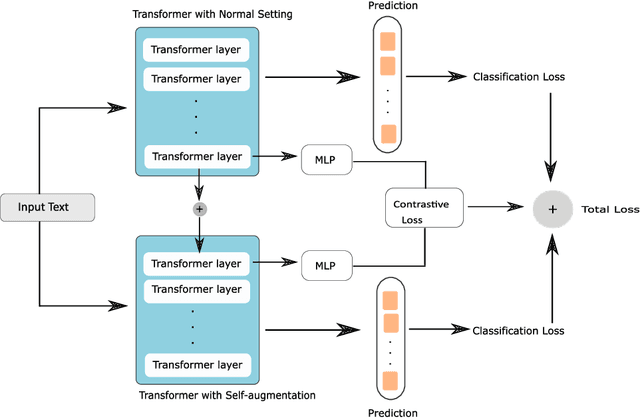

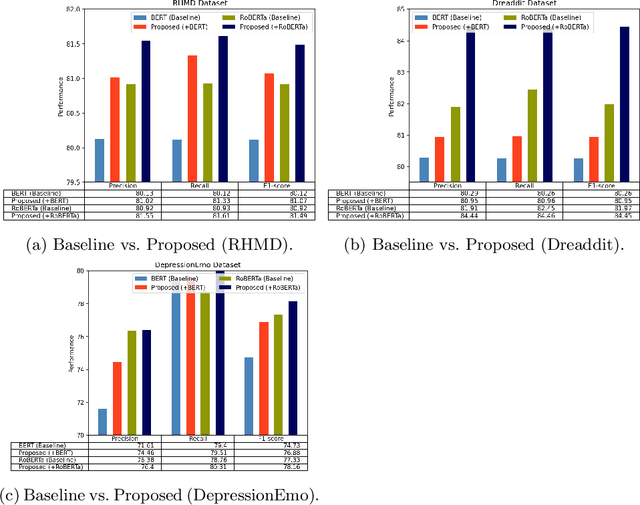
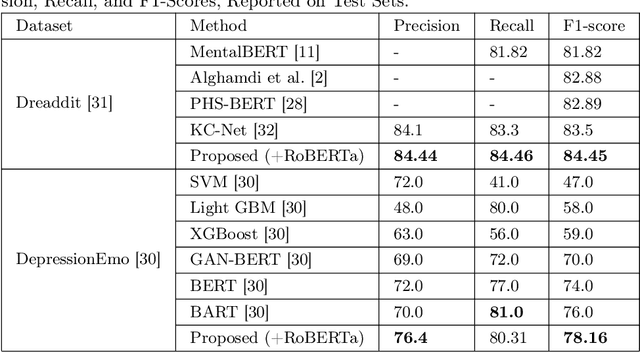
Abstract:Detecting diseases from social media has diverse applications, such as public health monitoring and disease spread detection. While language models (LMs) have shown promising performance in this domain, there remains ongoing research aimed at refining their discriminating representations. In this paper, we propose a novel method that integrates Contrastive Learning (CL) with language modeling to address this challenge. Our approach introduces a self-augmentation method, wherein hidden representations of the model are augmented with their own representations. This method comprises two branches: the first branch, a traditional LM, learns features specific to the given data, while the second branch incorporates augmented representations from the first branch to encourage generalization. CL further refines these representations by pulling pairs of original and augmented versions closer while pushing other samples away. We evaluate our method on three NLP datasets encompassing binary, multi-label, and multi-class classification tasks involving social media posts related to various diseases. Our approach demonstrates notable improvements over traditional fine-tuning methods, achieving up to a 2.48% increase in F1-score compared to baseline approaches and a 2.1% enhancement over state-of-the-art methods.
 Add to Chrome
Add to Chrome Add to Firefox
Add to Firefox Add to Edge
Add to Edge